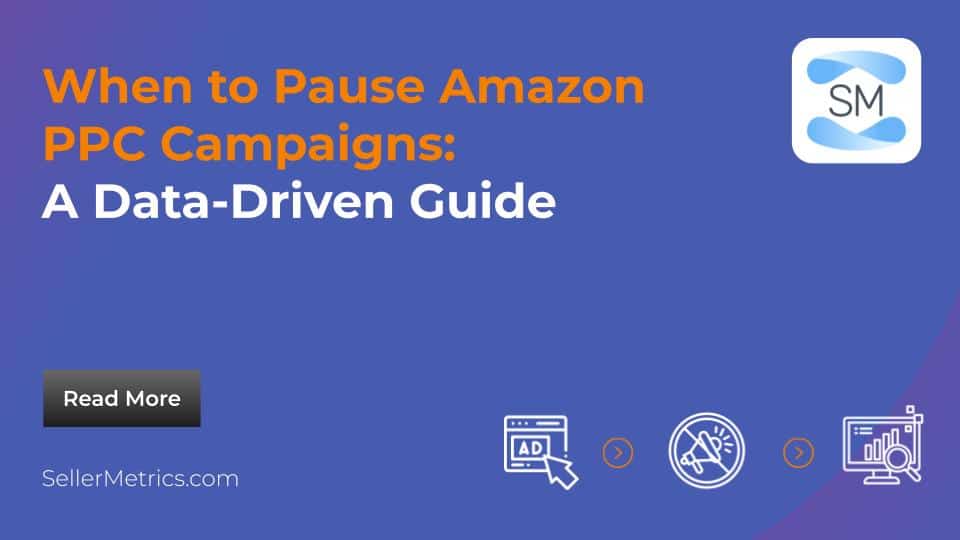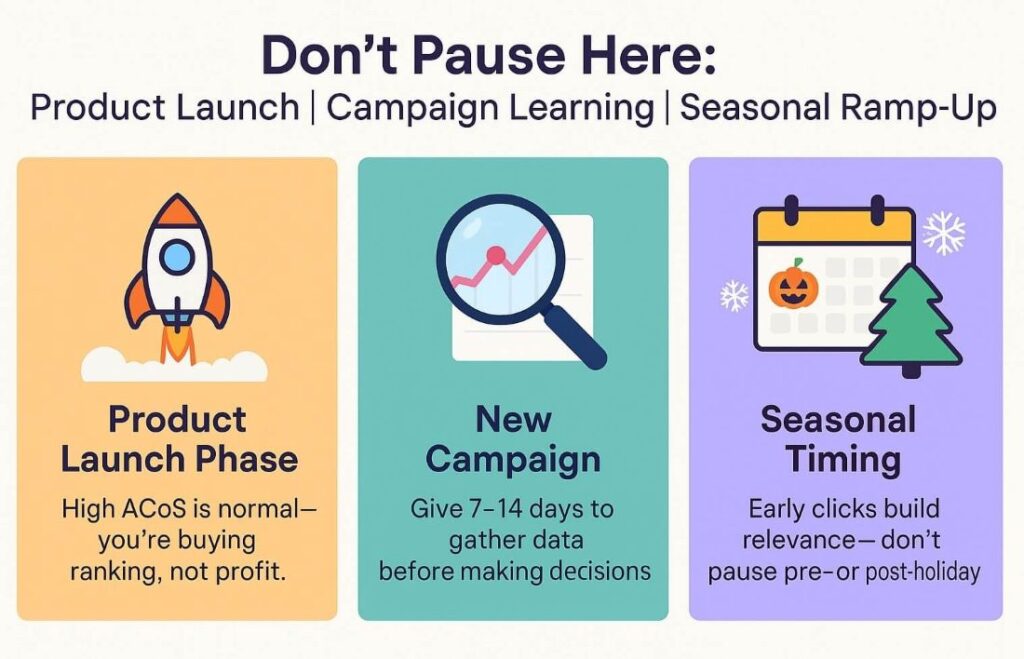3 November 2025
Amazon Advertising Strategy: 8 Novel Ways to Win (2025)
TweetLinkedInShareEmailPrint 8 min read By Rick Wong Updated Nov 03, 2025 TL;DR What is the best Amazon...

Amazon Pay-Per-Click (PPC) is the engine of growth for most sellers, but it can quickly become a cash bonfire if mismanaged. This leads to one of the most stressful and pivotal questions you’ll face: when to pause Amazon PPC campaigns? Acting too rashly can sabotage your sales velocity and organic rank, while hesitating can drain your profits. Making the right call requires moving beyond gut feelings and adopting a data-first mindset.
The decision to pause is never simple. It’s a strategic choice with significant consequences for the momentum of your business. Letting underperforming campaigns run unchecked will destroy your margins, but prematurely shutting down a campaign in its learning phase can stop a future winner in its tracks. The key is understanding the specific scenarios that justify a pause versus those that merely call for optimization.
This comprehensive guide will provide the clarity you need. We’ll explore every situation, from critical inventory shortages to stubbornly high ACoS, and equip you with a diagnostic framework to determine when to pause Amazon PPC campaigns. You’ll learn not only when to hit the brakes but also the smarter alternatives that can save a struggling campaign and protect your hard-won ranking on Amazon.
Article Contents
Before we dive into specific scenarios, it’s crucial to establish a core principle: pausing is a last resort, not a first response. In many cases, a campaign that appears to be failing is simply suffering from a correctable issue.
Always begin with a diagnostic check. Is your listing fully optimized? Are your bids too high? Have you neglected your search term reports? Answering these questions should be the first step in your Amazon SEO Strategy.
A campaign with a high ACoS might not need to be paused; it might just need a more aggressive list of negative keywords Amazon or a more refined bidding strategy. The answer to when to pause Amazon PPC campaigns is almost always “after you’ve exhausted all optimization options.”

Understanding these risks is the first step in determining when to pause Amazon PPC campaigns with strategic intent rather than panic. While optimization should always be your go-to, there are clear-cut situations where pausing your ads is the most logical and financially responsible decision. These are the red flags that demand immediate action.
This is the number one, non-negotiable reason to pause a campaign. Driving paid traffic to a listing that you cannot sell is not only a waste of money but is also actively harmful to your account’s health.
When you run out of stock, you don’t just lose potential sales; the damage is far deeper:
In this case, the decision of when to pause Amazon PPC campaigns is made for you. Conserve your remaining units for organic sales to soften the landing and restart your ads only after your inventory levels are stable.
The Rule of Thumb: When your inventory drops below three weeks of cover, it’s time to seriously consider pausing your ads. Preserve your remaining units for organic sales to soften the blow to your sales velocity.
Every seller has experienced it: a campaign with hundreds of clicks but a barren sales column. While a new campaign needs a learning period, a mature campaign that consistently fails to convert is a budget leak.
It’s time to pause when you see these patterns:
Before pausing, do a quick audit: Is your price competitive? Are your recent reviews positive? Have you lost the Buy Box? If the listing is healthy, pausing the campaign to prevent further financial drain is the correct move. This is a critical part of Amazon Sponsored Ads Management.
Advertising Cost of Sales (ACoS) and Total Advertising Cost of Sales (TACoS) are your key performance indicators for profitability. While a high ACoS can be a strategic investment during a product launch, a persistently high ACoS on a mature product is a red flag.
Pause campaigns where the ACoS has consistently exceeded your break-even point for over two weeks and you see no positive impact on your TACoS or organic ranking.
You wake up to find your impressions have vanished, your CPC has tripled overnight, or your ACoS has shot up by 200%. Do not let the campaign continue to bleed money.
A sudden, drastic change is often a symptom of an external problem:
In these situations, pause the affected campaigns immediately. Use Amazon analytics tools and check your account health in Seller Central to diagnose the root cause. Once you’ve identified and fixed the issue, you can safely resume your campaigns.

The temptation to pause can be strong, especially when you see a high ACoS. However, in the following scenarios, pausing can do more harm than good and disrupt your long-term growth.
During a product’s first 30-60 days, your primary goal is not profitability; it’s momentum. You need to generate sales velocity to teach the A9 algorithm which keywords your product is relevant for. Expect a high ACoS during this phase—consider it an investment in your organic future.
Pausing ads during a launch cuts off the fuel your product needs to climb the rankings. Instead of pausing, focus on optimizing your targeting and ensuring your listing is primed for conversion. Combining paid velocity with excellent on-page optimization from Amazon listing optimization services is the formula for a successful launch.
New campaigns, especially automatic or broad match types, are in a data-gathering phase. Amazon’s algorithm is exploring different search terms and placements to learn what works. The initial ACoS will likely be high and the performance erratic.
If you pause a campaign within the first week, you are making a decision with incomplete data. You never give the algorithm a chance to learn and self-optimize. Commit to a test budget you’re comfortable with and let the campaign run for at least 10-14 days before you start making major optimization decisions. This is a fundamental aspect of both manual PPC or automated PPC strategies.
If you sell seasonal products, shoppers often start browsing weeks or even months before they buy. Your ads for “Christmas decorations” might get clicks in October with few sales. Do not pause them. This early traffic builds relevance and keyword history, so when the buying surge hits in November, your campaigns are already warmed up and favored by the algorithm.
Similarly, don’t panic and pause campaigns immediately after a major holiday like Prime Day or Black Friday. CPCs are often inflated, and shopper behavior is abnormal. Give the market a week to stabilize before evaluating your ACoS.

If a campaign is underperforming but doesn’t meet the critical “pause” criteria, you have several powerful levers to pull that can fix the problem without sacrificing your momentum.
These optimization tactics should be your first line of defense. The true challenge of when to pause Amazon PPC campaigns often becomes a question of which optimization lever to pull first.

If you’ve had to pause a campaign, bringing it back online requires a careful “warm-up” strategy to avoid shocking the algorithm and burning your budget.
The question of when to pause Amazon PPC campaigns is not about finding a single “yes” or “no” answer. It’s about developing a strategic framework based on data, your specific business goals, and a deep understanding of the Amazon ecosystem. By distinguishing between critical failures and opportunities for optimization, you can protect your profits without sacrificing the momentum that fuels both your paid and organic sales.
True mastery of Amazon advertising comes from having crystal-clear visibility into your performance metrics. When you know exactly which campaigns are driving profitable growth and which are draining your budget, the decision to pause, optimize, or scale becomes simple. This is where having a powerful analytics dashboard is no longer a luxury—it’s a necessity.
Ready to take the guesswork out of your PPC decisions? Get in touch with SellerMetrics today and get the unparalleled clarity you need to optimize your campaigns, protect your profits, and scale your Amazon brand with confidence.
The best time depends on your specific product and customer behavior, but generally, sales peak in the evenings and on weekends. You can analyze your hourly sales data in Seller Central or use advanced Amazon PPC Software to identify your unique high-conversion windows. Scheduling your ads to run during these peak times, a practice known as dayparting, can significantly improve your ACoS.
Optimization is a continuous process involving several key actions that work together in your Amazon SEO and PPC efforts. This includes ongoing keyword harvesting from automatic campaigns, aggressive negative keyword implementation to cut wasted spend, bid adjustments based on profitability, and refining your ad copy and targeting. Regularly analyzing your search term and placement reports is the foundation of all successful optimization.
To stop a campaign, navigate to your Campaign Manager in Amazon Seller Central and find the campaign you wish to end. You can either set the campaign status to “Paused,” which stops it temporarily while preserving its history, or “Archived,” which removes it from your main view entirely. Pausing is recommended over archiving if you may want to reactivate the campaign in the future.
Success is measured by looking at a combination of metrics, not just ACoS. A successful strategy will show a healthy, profitable ACoS on mature campaigns, a decreasing TACoS over time (indicating organic growth), and an increase in total sales and keyword rankings. Using a dedicated Amazon PPC Agency or software can help you track these blended metrics effectively.
The single most crucial factor is relevance, which connects your product, your keywords, and your ad creative. When a shopper’s search term is highly relevant to your chosen keyword and your ad, they are more likely to click. If your product listing perfectly matches their expectations and solves their problem, they are more likely to convert.
Effectiveness is measured through key performance indicators (KPIs) like ACoS for campaign-level profitability and TACoS for overall account health. You should also track your organic rank for top keywords and total sales volume to see if your PPC efforts are successfully boosting your organic presence. For off-Amazon ads, using a tool like Amazon Attribution is essential to accurately measure sales driven by external traffic.